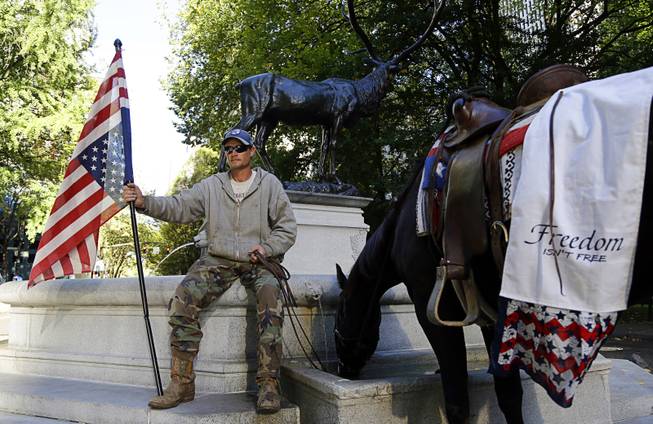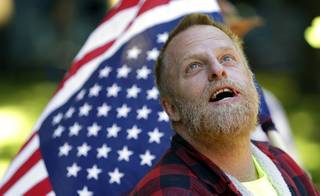
Don Ryan / AP
A protester sits outside the federal courthouse as his horse, Lady Liberty, gets a drink from a fountain in Portland, Ore., Tuesday, Sept. 13, 2016. The Bundy brothers, Ammon and Ryan, and five others are on trial after occupying a remote government outpost in Oregon’s high desert early this year.
Wednesday, Sept. 14, 2016 | 2 a.m.
Sixteen federal employees of the peaceful Malheur National Wildlife Refuge were preparing late last year how to deal with invasive fish threatening redband trout and other natural fish in Malheur Lake and migratory birds that flock to the sprawling 187,000-acre habitat.
What they never expected, Assistant U.S. Attorney Geoffrey Barrow told jurors Tuesday, was "an invasion far more serious than the common carp.''
Barrow, during opening statements in the long-anticipated Oregon standoff trial, used Ammon Bundy's own words caught on video Jan. 2 to argue that Bundy and his co-defendants aren't being prosecuted for holding a political protest, but for leading an armed occupation of the refuge.
He played a video of Bundy standing atop a snowbank in the Safeway parking lot in Burns in his blue plaid flannel jacket and cowboy hat, declaring, "Those who understand what has happened here ... I'm asking you to follow me to the Malheur National Wildlife Refuge. We're going to make a hard stand. ... We're going to insist the Constitution be protected here in this country.''
A retired Burns electrician Butch Eaton caught a ride with Ryan Bundy and others to the refuge that day and will testify how he saw the defendants, dressed in camouflage and armed, rack the slides of their firearms before clearing buildings at gunpoint.
The occupiers, Barrow said, established armed guards at the refuge's entry gates and watchtower, transformed the stone buildings into their personal residences, used office space and government computers as their own, dug through office records and replaced the signs, declaring the refuge the "Harney County Resource Center'' during the 41-day takeover. They also put two "Closed Permanently'' signs outside the U.S. Bureau of Land Management office in Burns, he said.
The group removed fencing, dug defensive trenches, divided into five military-style squads that trained in hand-to-hand combat and conducted firearms training at the boat launch, he said. Occupation spokesman Robert "LaVoy" Fincium "rifled through Native American artifacts and criticized how they were stored,'' Barrow added. FBI agents recovered more than 1,000 shell casings and dozens of firearms from the site.
"We are not prosecuting the defendants because they don't like the government,'' Barrow said. "In Ammon Bundy's words, 'This was much more than a protest.' They were taking a 'hard stand.' ''
Ammon Bundy's lawyer Marcus Mumford didn't deny that his client led the occupation, yet he argued that Ammon Bundy's intent wasn't to "interfere with some kind of nature study,'' but to return the land to the people -- "all because the federal government refuses to respect the limits of its powers.''
"He demands the federal government obey the law. The nerve!'' Mumford told jurors in his opening statements.
Ammon Bundy and his co-defendants, frustrated by the federal government's grazing and water rights restrictions on public land, believed in the need to restore more local control in the West. Discouraged that federal officials hadn't responded to their concerns, they needed to do something to draw attention to the plight of rural ranchers, loggers and miners, defense lawyers argued.
Most of the defendants arrived in Burns to protest the return to prison of Harney County ranchers Dwight Hammond Jr. and his son, Steve Hammond, both convicted of arson on federal land, their lawyers said.
"We came to help them,'' defendant Ryan Bundy told jurors.
After the march in Burns to support the Hammonds, several defendants had no idea about any plan to take over the refuge and simply followed Ammon Bundy and a caravan of cars leading to the property, their lawyers said. There, they said they never saw a federal land management employee and thought the refuge was closed for the winter.
Prosecutors and defense lawyers presented the conflicting portraits of the occupation at the opening to a trial that's expected to last more than two months. The government plans to call Harney County Sheriff Dave Ward as its first witness Wednesday morning.
Ammon Bundy met in November with Ward. The prosecutor described the meetings as threatening -- with Ammon Bundy telling Ward that if he didn't stand up to the federal government and protect the Hammonds, supporters would bring thousands of people to Harney County to do his job for him.
Bundy's lawyer countered that the meetings were cordial and accused the sheriff of misrepresenting Bundy's posture, saying, "He lies.''
Ammon Bundy, 41, and six co-defendants have pleaded not guilty to conspiring to impede federal employees from doing their work at the Malheur National Wildlife Refuge using intimidation, threats or force. Five of the seven also have pleaded not guilty to possession of a firearm in a federal facility. Ryan Bundy, Ammon's older brother, and co-defendant Kenneth Medenbach have pleaded not guilty to theft of government property.
At the refuge, Ammon Bundy was asserting his rights under the adverse possession principle, which he understood to be a legal way to occupy the refuge "in order to take it back,'' Mumford said.
Oregon resident Kenneth Medenbach joined with Ammon Bundy to provide support for the "voiceless rural people,'' his lawyer said.
"When Ammon Bundy said, 'Let's make our voices heard,' Ken Medenbach stood next to him to make his voice heard, knowing that two is stronger than one,'' his standby lawyer Matthew Schindler said. "His intent was to create awareness, awareness about the death of rural America.''
"It worked, after years of being ignored,'' Schindler said, noting the media coverage from around the world.
Schindler said Medenbach did "borrow'' a government truck to get groceries and argued that putting different signs over the ones at the refuge and BLM office rises to vandalism or criminal trespass at most. The cutting of 100 feet out of 2.3 million feet of fence around the refuge was minuscule and symbolic, he said.
"A 62-year-old carpenter, timber cutter, chain-saw artist certainly knows he's not shutting down the federal government,'' Schindler said.
Co-defendant Neil Wampler, a 68-year-old from California and Vietnam veteran, "found his people'' when he first met the Bundy brothers during the standoff in Bunkerville, Nevada, in 2014, his lawyer said.
Wampler traveled to Burns to protest the return to prison of the Hammonds and followed cars to the refuge, but "he had no idea where he was going,'' attorney Lisa Maxfield said. Once there, he set up shop as a cook in the kitchen.
While others who came to the refuge brought guns, there was "no one there to be aggressive towards,'' Maxfield told jurors.
The occupiers took a more defensive stance because they feared "they were soon going to be Waco'd or Ruby Ridge'd,'' Maxfield said, referring to two FBI aggressive showdowns in the 1990s that turned deadly.
As far as Wampler was concerned, "the Malheur refuge was just one big soapbox,'' she said.
Ryan Bundy and Shawna Cox, who are representing themselves, addressed jurors directly.
With a photo displayed to jurors of him standing beside his wife and seven of his eight children, Ryan Bundy described himself as a son of a rancher, member of the Mormon church and a family man who now "raises cattle, melon and children.''
Holding up a copy of a pocket Constitution, Ryan Bundy told jurors that he believes that governments are instituted by God for the benefit of man and that "human law'' should punish guilt "but never suppress the freedom of the soul.''
"I believe we were there not to break the law," he said, "but to enforce the law, to uphold the law ... the Constitution of the United States.''
He said he was thankful to be in court. "It's a marvelous thing to see a jury and let you decide,'' Ryan Bundy said.
Just before Ryan Bundy stood before jurors, the judge rejected his request to hand each a copy of a pocket Constitution, telling him out it's her role to instruct them on the law, not his.
Barrow objected five times during Cox's opening statement, and the judge had to steer her back on course.
U.S. District Judge Anna J. Brown told Cox that she could provide background on herself, "not a bio.'' Then, as Cox described in detail her religious beliefs, the judge interjected, "Ms. Cox you made the point, you're a woman of faith.'' Cox said she traveled to Burns to "save the Hammonds from the dangers of the federal government.''
Before then, she said, she had "never heard of the Malheur National Wildlife Refuge and never planned to go there.'' She followed a line of cars to the refuge and assumed it was closed for the winter. "There was no one there,'' she said.
Though prosecutors have said a witness saw Cox in the kitchen with a gun, she denied that, saying she left her two guns at home.
"We were in the kitchen making soup for the cold and hungry. ... I felt the spirit,'' Cox said. "The evidence will show we all believed and knew that what we were doing was perfectly legal.''
Defendant David Fry, who arrived at the refuge in his 1988 Lincoln Town Car on Jan. 8, was "barely noticed'' by law enforcement before the police shooting of Finicum on a rural road on Jan. 26, his attorney said.
With the arrests of the Bundys, Cox and others on the day of the shooting, Ammon Bundy told those remaining at the refuge to go home, Fry's lawyer Per C. Olson said. At that moment, the occupation had ended — "It's over. It's done,'' Olson said. What followed was "completely different, '' he said.
Fry and Jeff Banta were among four that stayed at an encampment on the western edge of the refuge for two more weeks. They weren't impeding employees from the Bureau of Land Management or Fish & Wildlife Service, Olson said.
"Instead, it basically was about a beef with the FBI,'' marked by substantial fear and confusion, he told jurors. Word had spread "like wildlife'' that Finicum had been killed while his hands were in the air and his knees were on the ground, Olson said.
Police said they fatally shot Finicum while he appeared to be reaching inside his jacket for a gun. A loaded 9mm gun was found inside his left jacket pocket.
Finicum had taken Fry under his wing at the refuge. Fry, who Olson said has been diagnosed with paranoid schizotypal personality disorder, had deep-seated fears and suspicion of the FBI. Fry didn't bring a gun to the refuge and only picked up a shotgun after Finicum's killing, Olson said.
By remaining at the refuge, Fry thought he could protect others by documenting what occurred on his YouTube video channel.
As the trial began, the courtroom was packed with defendants' relatives, supporters and media. Others watched on a live video feed in an overflow courtroom.
Oregon's U.S. Attorney Billy Williams sat through the entire day of opening statements. Oregon's FBI Special Agent-In-Charge Greg Bretzing joined him in the morning. They sat in front of the wives of the Bundy brothers.


Join the Discussion:
Check this out for a full explanation of our conversion to the LiveFyre commenting system and instructions on how to sign up for an account.
Full comments policy